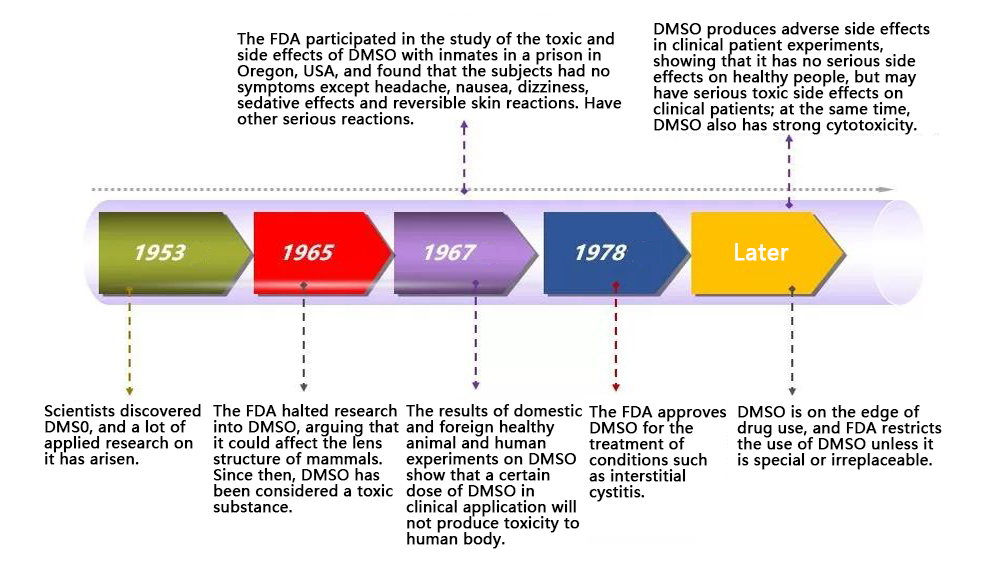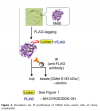Misunderstanding of "universal solvent" DMSO, have you been caught?
In the previous issues, we introduced various formulations and strategies for drug dissolution. Among them, DMSO, which is not recommended, also has a place as a co-solvent, but it is quite controversial. The use of this solvent, which is restricted by the FDA, is widely spread and is highly toxic. How toxic is it, and how do we use it in our experiments? Today we will reveal to you the correct use of "universal solvent" DMSO in cell and animal experiments.
Introduction to DMSO
Dimethyl sulfoxide (DMSO) is a sulfur-containing organic compound whose structure is shown in the figure below.

Physical properties: It is a colorless and odorless transparent liquid at room temperature, with strong hygroscopicity, the freezing point is 18.55℃, and the density is close to that of water, which is 1.100 g/mL;
Chemical properties: The molecular formula is (CH3)2SO, because the structure has a hydrophilic sulfinyl group and two hydrophobic methyl groups, it is compatible with both aqueous solutions and most organic solvents except petroleum ether; it can be dissolved About 80% of the compounds, most of the water-soluble compounds and fat-soluble compounds can be dissolved by it, so DMSO is also known as "universal solvent".
Development history of DMSO
DMSO was called "magic medicine" because of its wide range of uses in the early stage of discovery. Scientists have carried out a lot of research, mainly including anti-inflammatory and pain-relieving, diuretic, sedative and other effects. In the early pharmaceutical industry, DMSO can be directly used as some drugs. Raw material and carrier, it can also be used as an osmotic protective agent, platelet cryopreservation agent, etc.
However, in 1965, research on DMSO in the United States was abruptly stopped because a research symposium on DMSO attended by the FDA and some pharmaceutical companies pointed out that DMSO was found to affect the lens structure of many mammals, but not in humans and primates. No such change was found.
The following picture shows the development of DMSO: It can be seen that since 1965, scientists have carried out extensive research on the toxicity of DMSO, but they have not found that it has serious toxic and side effects on healthy experimental animals and humans, but it is toxic to cells. Therefore, DMSO is restricted by the FDA from being used in non-special non-irreplaceable situations.

Development history of DMSO in recent decades
How toxic is DMSO?
1. Cytotoxicity of DMSO: need to control <0.1% (v/v)
• In 2008, Qi Weidong et al. found that when the culture medium contained 0.1%-0.25% (v/v) DMSO, there was no damage and effect on rat hair cells within 24h, but the DMSO content in the culture medium reached 0.5%- At 6 %, hair cell damage and dose-dependent cell death occurred [2].
• In 2014, He Bing et al. found that different concentrations of DMSO in the cell culture medium had certain effects on the growth of rabbit chondrocytes cultured in vitro. When the concentration was 2.0% (v/v), the chondrocytes appeared stronger. Inhibitory effect, but little effect on cell growth in the concentration range of 0.1%-1.0% [4].
2. Enzymatic toxicity of DMSO: need to control <0.1% (v/v)
• In 2011, Ramakrishna Nirogi et al. found that in the incubation experiment of human liver microsomes, DMSO with a content of more than 0.1% in the incubation system could inhibit the activity of CYP1A2 in human liver microsomes. However, 2% methanol or acetonitrile had no effect on the enzyme activity [5].
• In 2003, Masuhiro NISHIMURA et al. found that when the compound was administered to human hepatocytes, the final concentration of DMSO was 0.1% or lower, and the drug phase metabolizing enzyme cytochrome P450 enzyme isoforms (CYPs) in hepatocytes , The expression of biphasic drug-metabolizing enzyme glucuronyltransferase isoforms (UGTs) and the main transmembrane transporter ABC transporter (ATPBing Cassttee Transporters) in cells has no effect, and its expression will change when the concentration is higher[ 6].
3. Animal toxicity of DMSO
(1) Acute toxicity: refers to the rapid and severe poisoning reaction produced by the body after receiving a large dose of a drug at one time, including the death effect; generally the median lethal dose (LD50) of the drug can be obtained. DMSO (g/kg) must cause 50% of the test animals to die to assess the risk. The following results have been reported in various animal experiments:
The following table lists the half-lethal dose of DMSO for each experimental animal under each administration method. It can be seen from the table that the LD50 of DMSO is actually higher. For example, the LD50 of oral administration to mice is 16.5-24.6g/kg, while our The dose administered in mouse experiments is generally in mg/kg, so it is almost impossible to exceed this dose, which means that the overall toxicity to animals is not as strong as cells. The data provided by different laboratories may not be exactly the same, but all confirm the low toxicity of DMSO in animals.

The median lethal dose (g/kg) of DMSO in different species and different administration methods.
(2) Long-term toxicity: refers to the harmful effects of the drug administered to the test animals at a certain grade dose for several consecutive days. The following results have been reported in various animal experiments:
a. Dosing experiments in animals such as dogs, pigs, and rabbits administered DMSO at a dose of 5 g/kg.d have also shown that, after several months, the animals will experience changes in lens diopter rather than opacity, and this change is dose-dependent. The relationship between DMSO dose reduction and lens refraction is very small; no such side effects have been found in primates (including humans) so far [7];
b. The dose of DMSO was 9 g/kg·d, and the experiment of rhesus monkeys administered continuously for 18 months showed that the rhesus monkeys had no obvious abnormality or intolerance [8];
c. DMSO was administered at a dose of 1g/kg 5d/week for 12 months in male and female rats. The experiment showed that all tissues and organs of rats, such as brain, heart, intestine, reproductive system, thyroid, etc., were normal, and no obvious abnormality was found. or intolerance [[9].
d. DMSO has a diuretic effect, but no renal damage has been found in human and laboratory animal studies.
From the above toxicological data, it can be seen that compared with other safe and non-toxic solvents, although DMSO has certain toxicity, DMSO also has its own unique properties. Before the "universal solvent", biological experiments and preliminary drug screening stages can also use DMSO reasonably to quickly make correct experimental results without the interference of reagent factors. Let's take a look at how to properly use DMSO in an experiment.
How to use DMSO correctly in cell experiments?
There are two main applications of DMSO in cell experiments:
1.Cell cryopreservation: DMSO is currently the best cell cryopreservation agent, but it has certain toxicity. Generally, the concentration is controlled below 10% of the final volume, and can be reduced to below 10%, such as 8%, for cells with weak tolerance. Note that DMSO should be washed off as soon as possible during cell recovery, otherwise it will cause severe cell toxicity. The results showed that when the concentration of DMSO in the culture medium was 10%, the cell growth inhibition rate was nearly 100%; when the concentration was 1%, the inhibition rate was 35%. Even at a concentration of 0.04%, DMSO had an adverse effect on cell growth[10] .
2.Solvents of compounds for cell administration: DMSO should strictly control the dosage of DMSO when administering lysing compounds to cells: Different cells may have different sensitivity to DMSO content, but now it is more acceptable to use DMSO to formulate compounds for cell administration, the final concentration of DMSO is controlled Within 0.1%, it is considered that there is no interference with the cell experiment, that is, the volume of DMSO cannot exceed 1 μl in 1 ml of medium. If it is found that the volume exceeds this ratio, we can reduce the use of DMSO by increasing the drug concentration, or using a multi-step dilution method in the aqueous phase.
How to properly use DMSO in animal experiments?
The application of DMSO in animal experiments mainly lies in the dissolution of drugs. In the previous issues, we introduced the dissolution method of drugs, but when dissolving drugs, we must first consider the toxicity of the co-solvent, and then consider the solubility. If it exceeds the toxicity ratio In order to dissolve the drug, we must abandon this method of dissolution.
From the above toxicity test data, we can see that the overall toxicity of DMSO to animals is far less than that of cells, so Li Ping et al. also believed that the amount of DMSO used in animal administration can account for 10%-20% of the total administration volume [ 11], for example, the administration volume of mice during oral administration is 10mL/kg, for 20g mice, our single administration volume is about 100-200μl, and the volume of DMSO must be controlled at 10%-20%, that is, 20 -40μl.

Recommended volume of DMSO in animal experiments
Note: The volume of DMSO used is for reference only. If animals have adverse symptoms, such as weight loss/appetite loss, we should consider reducing the amount of DMSO used. The general principle is to minimize the use of DMSO.
Precautions in the use of DMSO
1. Avoid skin contact: Studies have found that DMSO has a small molecular weight and is easily absorbed through the skin. If the skin is exposed to DMSO for a long time, it will show small local irritation, such as local skin irritation, itching, and burning. During the experiment, 1%-5% ammonia water can be prepared for use. After the skin is touched, it should be washed with a large amount of water and dilute ammonia water; Sulfones can penetrate the skin and, under certain conditions, can bring toxic substances into the skin;
2. Avoid inhaling DMSO: The most common causes of inhalation of DMSO are nausea, vomiting, and the smell of garlic, onion, and oyster in exhaled air. High concentration and large area use can affect nerve function and lead to hemolysis, so avoid its volatilization when using it.
To sum up, this is the basic knowledge about DMSO and the application methods in the experiment that we have introduced to you in this issue. Does it give you a new understanding of DMSO? Although DMSO has certain toxicity, it is not unusable; when we have not found a suitable substitute, it is still permitted to apply DMSO to the experiment to obtain research data in moderation. If you have different voices and opinions, please leave us a message or participate in the group chat below to discuss together!










Comentarios